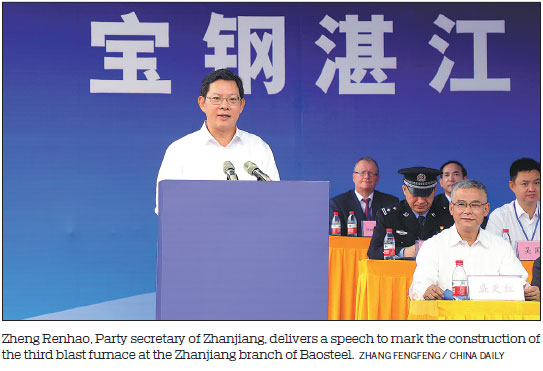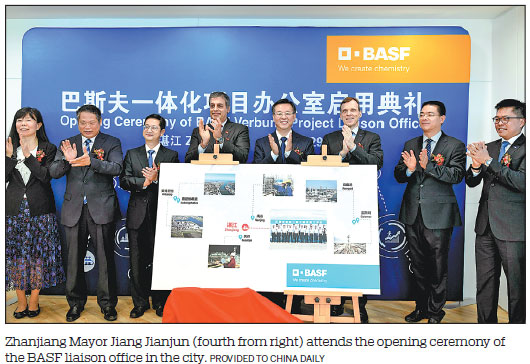Home> News
Projects to enhance city's role as hub
A group of large investment projects began construction in Zhanjiang in the
southern Guangdong province, to prop up the burgeoning city's new status as a
regional hub.
According to the local government, a total of 73 major projects will break ground with an accumulative investment of 46 billion yuan ($6.8 billion) in 2019. That's compared to 42 billion yuan last year.
Of the projects, 11 with nearly half of the planned total annual investment amount, or 22.9 billion yuan, broke ground in the first quarter.
Once a less-developed city in Guangdong, Zhanjiang has become more attractive to investors since the provincial government positioned it as a sub-center in the province at the end of 2017, meaning it was promoted to a position on par with Zhuhai and Shantou, and only behind Shenzhen and Guangzhou, two economic powerhouses of the province.

A hub city for the 21st Century Maritime Silk Road, Zhanjiang offers a convenient passageway for cargo shipment between Southwest China and the world. Lang Shuchen / For China Daily
Located on the west wing of Guangdong, Zhanjiang was given the same importance as Shantou, on the east wing, as one of two new engines to bolster the province's economic growth by developing a modern coastal economic belt.
"Zhanjiang will actively grab the favorable opportunities granted by the central and provincial governments ... and stick to the opening-up policy to promote regional integration," said Zheng Renhao, Party secretary of Zhanjiang.
To fulfill the goal, Zheng said the city government identified a strategy of building a passageway, a free trade port and a pilot zone, which put the emphasis on the construction of a modern transportation system, on wider opening-up to highlight the city's pivotal role in the Maritime Silk Road, and on the development of a modern industrial system.
Among projects that kicked off in the first quarter, the Zhanjiang branch of Baosteel, one of China's largest steel makers, plans to invest roughly 19 billion yuan in the construction of its third blast furnace.
According to the company, the new blast furnace will focus on the production of hot-rolled and cold-rolled ultra-high-strength steel and auto body sheets, while adopting a new ultra-low emission standard.
The operation of the new blast furnace, which is due in July 2021, will raise the annual production of iron melt of the facility to nearly 12.3 million metric tons, molten steel to about 12.5 million tons and steel products to roughly 10.8 million tons. All the figures are far higher than the designed capacity of the facility, which began production in 2015.
The company, located on Donghai Island in Zhanjiang, has been the major part of the city's plan to build a world-leading environmentally friendly near-port heavy industrial base, which is mainly comprised of steel, chemicals and papermaking.
In 2018, the industrial output value of the three sectors hit 110 billion yuan, accounting for nearly half of the city's total, official figures show.
In Xiashan district of Zhanjiang, the city's central area, a pharmaceutical center laid the foundation on March 29 and will begin service in October.
The center, with an investment of nearly 100 million yuan, will be one of the largest storage and logistics centers for pharmaceutical products in West Guangdong. It will be equipped with a five-story warehouse and meet the standard of good supply practice certificate for pharmaceutical products.
The city will also build a new expressway to link with the local railway station and a terminal control center to serve the expected busier air traffic.
The expressway will also connect a highway that goes all the way to Yulin in the neighboring Guangxi Zhuang autonomous region.
With an investment of 372 million yuan, government officials said the 3.37-kilometer-long expressway is significant to the economic development of areas along the line.
Besides highway linkage, Zhanjiang is building a new international airport, which will be the third-largest international airport of Guangdong when it is put into operation by the end of 2020.
As an affiliated project to the new airport, a terminal control center started construction in March with a total investment of 460 million yuan.
When it is put into service in 2021, the control center will work together with the other two centers in Guangzhou and Zhuhai to safeguard aviation safety for flights to and from Guangdong, Guangxi and Hainan.
In 2018, the local government invested a total of 16.7 billion yuan in local transportation infrastructure, up 61 percent from the previous year, to upgrade the city's roads, railways, the airport and the seaport, according to official statistics.



 Print
Print Mail
Mail 5G construction supports Zhanjiang's high-quality development
5G construction supports Zhanjiang's high-quality development
 Acting mayor inspects project construction in Xuwen, Leizhou
Acting mayor inspects project construction in Xuwen, Leizhou Zhanjiang island an "egret paradise"
Zhanjiang island an "egret paradise"  Dancing egrets add vitality to Xiashan
Dancing egrets add vitality to Xiashan